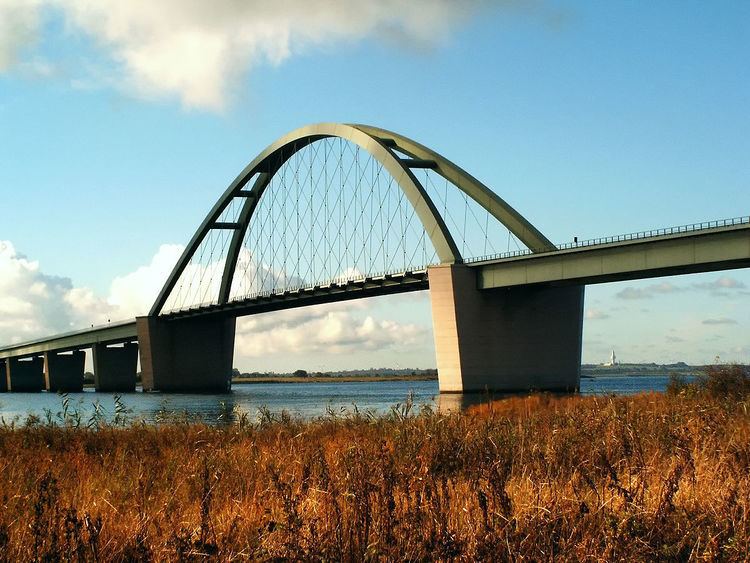Height 67 m (219 ft 10 in) Clearance above 23 m (75 ft) Total length 963 m Construction started January 1960 | Width 21 m (68 ft 11 in) Longest span 248 m (813 ft 8 in) Address B207, Germany Clearance below 23 m | |
 | ||
Hours Open today · Open 24 hoursFridayOpen 24 hoursSaturdayOpen 24 hoursSundayOpen 24 hoursMondayOpen 24 hoursTuesdayOpen 24 hoursWednesdayOpen 24 hoursThursdayOpen 24 hours Similar Burgstaaken, Fehmarn Belt Fixed Link, Leuchtturm Flügge, Meereszentrum Fehmarn, Puttgarden station | ||
The Fehmarn Sound Bridge (German: Fehmarnsundbrücke) connects the German island of Fehmarn in the Baltic Sea with the German mainland near Großenbrode.
Contents
- Die fehmarnsundbr cke the fehmarn sound bridge
- Description
- Route and ferry changes
- Historic monument
- Cold War explosive charges
- Future
- References
Die fehmarnsundbr cke the fehmarn sound bridge
Description
The 963-metre-long (3,159 ft) crossing includes the 248-metre-long (814 ft) network arch bridge which carries road and rail over the 1,300-metre-wide (4,265 ft) Fehmarn Sound. Construction began in 1958 and the bridge was opened on April 30, 1963. The main span is 23 metres (75 ft) above the sea, which allows shipping to pass through. The bridge is constructed of steel and is 21 metres (70 ft) wide; 6 metres (20 ft) are used by Deutsche Bahn for a single rail track, part of the Lübeck–Puttgarden railway, the rest for a pedestrian walkway and two-lane roadway. The two steel arches, from which the central span is suspended by cables, are braced with steel cross-beams. The arches are 248 metres (810 ft) in length and reach 45 metres (150 ft) above the main deck of the bridge. The bridge was designed by engineers G. Fischer, T. Jahnke und P. Stein from the firm Gutehoffnungshütte Sterkrade AG, Oberhausen-Sterkrade. Architect Gerd Lohmer helped with the architectural design.
Route and ferry changes
At the same time as the opening of the bridge, changes were made to ferry services. The previous ferry service to the island of Fehmarn was discontinued. The service from Großenbrode Quay, Germany to Gedser, Denmark, crossing both Fehmarn Sound and the Fehmarn Belt, was replaced with a new service from Puttgarden (on Fehmarn) to Rødby, Denmark crossing just the Fehmarn Belt. The new bridge and ferry changes brought about a substantial time saving for both road and rail traffic along the so-called Vogelfluglinie (literally "bird flight line") from Hamburg to Copenhagen.
Historic monument
The Fehmarn Sound bridge was declared an historic monument in 1999 by the State Office for Protection of Historical Monuments of Schleswig-Holstein in Kiel, and has since become a symbol of both Fehmarn and Schleswig-Holstein.
Cold War explosive charges
As the bridge was built during the Cold War, six explosive vaults were embedded below the approach road on the mainland side to be used in case of invasion. Their location is given away even today by six square asphalt patches. The vaults were connected to a control point about 1 km (0.6 mi) away in Heinrichsruh.
Future
A Fehmarn Belt Bridge was proposed, between Denmark and Germany, with four lanes (2+2) and double track railway. But according to the agreement between the two countries, the Fehmarn Sound bridge will remain as it is, one lane per direction and a single railway track. However, in December 2010 a tunnel was chosen as the preferred means of spanning the strait.
In the event of severe congestion a copy could be built next to it, but no replacement since it is a historic monument.
